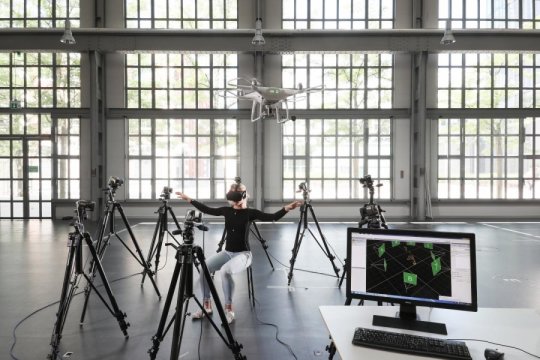[ad_1]
Imagine piloting a drone using the movements of your torso only and leaving your head free to look around, much like a bird. EPFL research has just shown that using your torso to pilot flying machines is indeed more immersive — and more effective — than using the long-established joystick. The results are published in today’s issue of PNAS.
“Our aim was to design a control method which would be easy to learn and therefore require less mental focus from the users so that they can focus on more important issues, like search and rescue,” says lead author Jenifer Miehlbradt of EPFL’s Translational Neuroengineering Laboratory led by Bertarelli Foundation Chair Silvestro Micera. “Using your torso really gives you the feeling that you are actually flying. Joysticks, on the other hand, are of simple design but mastering their use to precisely control distant objects can be challenging.”
The scientists wanted to observe how people use their bodies to pilot a flying object, in this case a drone, and determine which movements are most intuitive and natural — approaching the pilot problem from a completely new perspective.
They started by monitoring the body movements of 17 individuals thanks to 19 markers placed all over the upper body as well as their muscular activity. Each participant followed the actions of a virtual drone through simulated landscapes that passed-by as viewed through virtual reality goggles.
Motion patterns emerged and the scientists quickly established torso-related strategies for piloting drones: they found that only 4 markers — located on the torso — were needed to pilot flight simulators and real drones through a circuit of obstacles effectively.
Overall, the scientists compared their torso strategies to joystick control in 39 individuals. They found that torso drone control outperformed joystick control in precision, reliability and with minimal training sessions.
“Data analysis allowed us to develop a very simple and intuitive approach which could also be used with other populations, machines, and operations,” says Micera, also at the Scuola Sant’Anna in Italy in Biomedical Engineering. He adds, “The approach significantly improves the teleoperation of robots with non-human mechanical attributes.”
While the PNAS results provide a truly new and completely immersive piloting strategy with a focus on characterizing the relevant torso parameters, leaving the head, limbs, hands and feet free to perform other actions, their proof-of-concept system still requires body markers and external motion detectors in order to work.
The next steps are to make the torso strategy completely wearable for piloting flying objects. The application range is huge, from flight simulators to piloting drones and even perhaps planes of the future. A garment that implements the torso strategy into drone control without external motion detectors was developed at EPFL based on the PNAS findings.
Video: https://www.youtube.com/watch?v=LLam4TNVi_g
Story Source:
Materials provided by Ecole Polytechnique Fédérale de Lausanne. Note: Content may be edited for style and length.
[ad_2]















